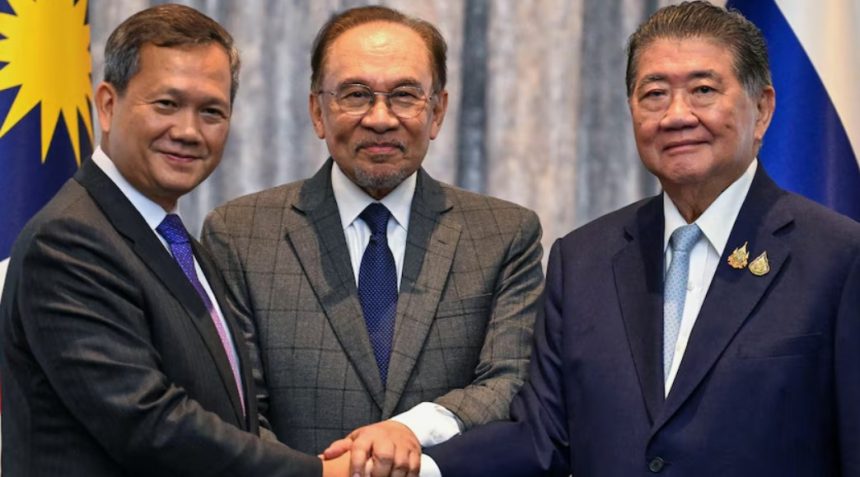Thailand and Cambodia: Ceasefire Brings Temporary Calm Amid Cross-Border Turmoil
A ceasefire has been reached between Thailand and Cambodia after a week of fierce border clashes that killed dozens and forced over a quarter of a million people from their homes.
The move comes after a dramatic spike in hostilities along a disputed frontier that has long been a flashpoint of nationalist sentiment and diplomatic tension.
The fragile agreement was struck during a high-level meeting in Malaysia on Monday between Cambodian Prime Minister Hun Manet and Thailand’s acting Prime Minister Phumtham Wechayachai. Both leaders agreed to an “immediate and unconditional” ceasefire, effective from midnight on 28 July.
The violence, which erupted on 24 July, centred on a stretch of land near the ancient Ta Muen Thom temple along the Thailand-Cambodia border.
Reports say at least 35 lives were lost in the exchanges, including civilians, one of them an eight-year-old child. More than 260,000 people have been displaced across both countries.
Thailand’s foreign ministry claimed Cambodian forces launched “heavy artillery” fire at a Thai military post and surrounding civilian infrastructure.
In retaliation, the Thai military said an F-16 jet had targeted Cambodian military assets.
Cambodia responded harshly. Its defence ministry accused Thailand of violating its sovereignty and of bombing areas near the UNESCO-listed Preah Vihear temple.
It “strongly condemns the reckless and brutal military aggression of the Kingdom of Thailand against the sovereignty and territorial integrity of Cambodia.”
Fighting continued until late Monday, with both sides reporting active exchanges just hours before the ceasefire deal. “The Thai assault was ‘ongoing and strong’,” confirmed Cambodian defence spokesperson Maly Socheata.
Tensions between Thailand and Cambodia over their shared 817-kilometre border are nothing new. Disputes date back to colonial-era maps drawn in the early 20th century.
These skirmishes, particularly around temple zones like Preah Vihear, have erupted sporadically over the years. A major flare-up in 2011 led to a weeklong artillery exchange and numerous casualties.
But the most recent spiral began in May when a Cambodian soldier was shot dead in a minor clash. What followed was a chain reaction of diplomatic fallout, border closures, and inflammatory rhetoric.
In one key development, Thailand sealed its land border with Cambodia, halting nearly all cross-border movement except for essential cases—a move that added significant pressure to the already tense situation. Thailand seals border with Cambodia amid escalating clashes.
Cambodia retaliated by banning Thai entertainment imports, halting trade in key commodities like fuel and fresh produce, and even downgrading diplomatic ties.
Then came the landmine incidents—explosions that injured eight Thai soldiers. Thailand accused Cambodia of laying new Russian-made mines in agreed safe zones. Cambodia dismissed the claims as “baseless”, suggesting the devices could be remnants from past conflicts.
The diplomatic row escalated quickly. Ambassadors were expelled. Embassies were emptied. Trust, already fragile, was shattered.
In Thailand, domestic politics added fuel to the fire. Paetongtarn Shinawatra, former prime minister and a powerful figure in Thai politics, was recorded referring to Cambodia’s influential ex-leader Hun Sen as “uncle” in a leaked call.
She also criticised her own country’s military. The fallout was swift, Shinawatra was suspended from her post on 1 July. Her close ally, Phumtham Wechayachai, stepped in as acting prime minister.
The leak, while seemingly a personal exchange, sparked nationwide protests and further eroded confidence in the Thai leadership.
Peace talks were initiated under the banner of ASEAN, with Malaysian Prime Minister Anwar Ibrahim acting as a mediator. US President Donald Trump added international weight to the negotiations, warning both sides of stalled trade deals if fighting continued.
“Today we have a very good meeting and very good results… that we hope to stop immediately the fighting that has caused many lives lost, injuries and also caused displacement of people,” said Cambodian PM Hun Manet.
He also acknowledged the diplomatic nudges from the US and China that helped push the agreement forward.
Thailand’s Wechayachai, initially sceptical about Cambodia’s intentions, confirmed the ceasefire was reached in “good faith by both sides”.
The underlying issues remain unresolved. The dispute over the 1,000-year-old Preah Vihear temple continues to simmer. Cambodia has long used a 1907 French map to assert its claim, a reference Thailand disputes as inaccurate.
Though the International Court of Justice awarded sovereignty of the temple to Cambodia in 1962—and reaffirmed that ruling in 2013—Thailand has never fully accepted it.
Despite Monday’s breakthrough, the uneasy peace may be short-lived. Trust has been badly damaged. Each side continues to view the other with suspicion. The potential for renewed fighting remains high unless lasting diplomatic solutions are found.
For now, the guns have gone quiet. But the border, steeped in history and soaked in tension, is far from calm.






